Blog
Top 10 hand tools for every tool box
Like many families, I too inherited many of my hand tools from my father and even my grandfather. My old man would keep the tools in an old upright biscuit tin box. I had to discard the tin box since the space between the shelves in my garage is not high enough. Over the years, I have added many tools of my own as well, and my wooden toolbox was starting to look rather crowded and overflowing. For some time, I had been toying with the idea of getting myself a new toolbox, the five-compartment type that will allow me to store my tools in a more organized manner. In the meantime, I inventoried my hand tools and have set aside 10 of the most useful, beginning with the heaviest.

1. Hammers: I have two hammers, a metal Engineer's type and a Nylon mallet. The Engineer's Hammer is a general-purpose tool, weighs 1lb. and has a comfortable wooden handle. Unlike a ball-pein hammer, the two ends of the head are identical and hexagonal rather than circular. The head is hardened steel and less likely to chip when hammering. In addition, hexagonal ends allow better reach near corners. Some people prefer a claw hammer as it can double as a Nail-Puller. My experience says a separate Crowbar type Nail-Puller is a more versatile instrument compared to a claw hammer.
I sometime work with wood and sheet metal as well, and a Nylon mallet is very useful. We had a wooden mallet earlier, but the nylon is better. The ends of the hammer are made of nylon and therefore they do not leave severe dents or scratch marks on sheet metal or wood as a metal hammer does.

2. Crowbar – Nail-Puller: This is a very handy tool when pulling out nails from wood. Many times, the nail is embedded deep in the wood and it is difficult to reach below its head to get a grip on it. Light taps with a hammer on the crowbar makes its claws go under the nail to lift it easily. That is why I prefer a separate crowbar rather than a claw hammer. When long nails have to be pulled, a claw hammer does not offer sufficient leverage, whereas head of a hammer placed under the crowbar works wonders.

3. Pliers: One needs nippy handy tools such as pliers for several odd jobs around the house. I never know when I have to fix a busted water pipe or extend the electrical wiring to add an extra light fixture. I have in my toolbox Combination pliers, Side-cutting pliers, Water-pump pliers, Locking pliers and Long-nosed pliers.
I use the Combination pliers for the heavy-duty jobs such as cutting thick wires or bending thick sheets of metal. Side-cutting pliers help with the electrical work such as peeling off insulation from wires and for trimming and dressing joints. Long-nosed pliers are very handy for holding tiny screws or for picking up tiny parts from difficult-to-reach areas. Water-pump pliers and Locking pliers, being adjustable, are very useful when you are working on pipes or when changing taps. I always check out the insulation on the handles of my pliers periodically to safeguard my health from electric shocks.

4. Chisels: For minor woodworking jobs, I have a Wood Chisel in my toolbox. I find it very useful when removing peeling paint from furniture that I am planning to repaint, or trimming the edge off a new panel that is just not fitting in its groove. For working on metal, I use a Cold Round Chisel and a Cold Flat Chisel, made from hardened steel. The flat chisel is handy for knocking off burrs from edges of holes drilled into metal. With the round chisel, I can make a quick hole in the wall, even if it is made of concrete.

5. Clamps: I always keep two types of clamps in my toolbox. One is a medium sized C-Clamp, which serves to hold together things that are being glued. If you are working with wood more often, you may need more numbers of them.
The other clamp I keep is a Toolmakers clamp. Although a little clumsy to operate (the clamp has to be closed from two sides), the flat parallel surfaces hold objects without deforming them. The two mating surfaces also have tiny grooves cut in them, so that thin round objects do not slip and turn around when clamped within the grooves.

6. Files: An occasional filing is necessary while working on both wood and on metal. Mainly for woodworking, I use a Half-Round Bastard Cut file. It has large rough teeth that bite into wood easily without getting clogged. One side is flat, while the other is round and this helps me file flats or grooves in wood.
For working on metal, I use a Medium Flat File. This is good enough for removing sharp edges and burrs, which may otherwise be dangerous. If I have to enlarge a hole in a metal piece, I use my Medium Rat-Tail File; this is a round file. I have handles fitted to all my files and it's a comfort to my hands when working.

7. Screwdrivers: I keep a few screwdrivers in my toolbox - one set of medium and large Slotted Screw Drivers, one set of medium and large Philips Screw Drivers and one set of Combination Screw Drivers. Most wood screws have slots for diving them, but Philips type are not so rare. The Philips type screws have two slots at right angles to each other on the head, which makes the screwdriver grip the screw more securely when turning them.
The Combination Screw Driver has a common handle and bits of several sizes. Some of the bits are for slotted screws, some for Philips screws and some for Star screws, which are somewhat rare.

8. Spanners & Wrenches: For working with pipes and plumbing, I find a Pipe Wrench to be an invaluable tool. Its adjustable, slanting and serrated jaws help in gripping slippery pipes firmly for turning. For turning nuts and bolts, I use a medium size Adjustable Crescent Wrench, which I can adjust for the size.

9. Saws: I keep a Hacksaw and a Handsaw in my toolbox. While a Hacksaw is a better fit for cutting metal, a Handsaw is suitable for sawing wood. I keep the Handsaw, Hacksaw and the wood chisel in a separate compartment in the toolbox as all of them have sharp edges and could be damaging to fingers when rummaging through the toolbox.

10. Measurement and Marking tools: Measuring and marking while working is a necessary step for maintaining accuracy. While my Tape Measure helps me to measure distances accurately, my Spirit Level tells me whether I have a perfect alignment. For making marks on wood or metal while working, I use a Metal Scriber or a Knife. When I have to find the center of a circle or I need to mark a right angle, I use my Right-Angled Square. When transferring measurements between immobile objects, I use my Spring Calipers. All the above tools occupy a separate compartment in my toolbox.
Depending on what type of work you do most, your tools may differ from what I use. Whatever tools you may use, I would advise you to go for the best brands you can buy. Apart from tools, you must also have a pair of Safety Glasses and a First-Aid Box handy. The first protects your eyes and the second helps you to bandage your bloody thumb.
overall rating:
my rating:
log in to rate

